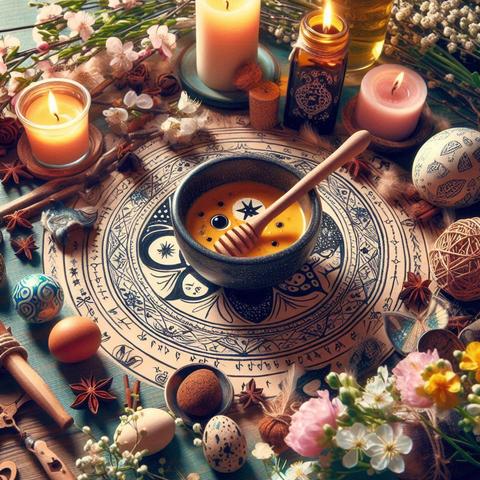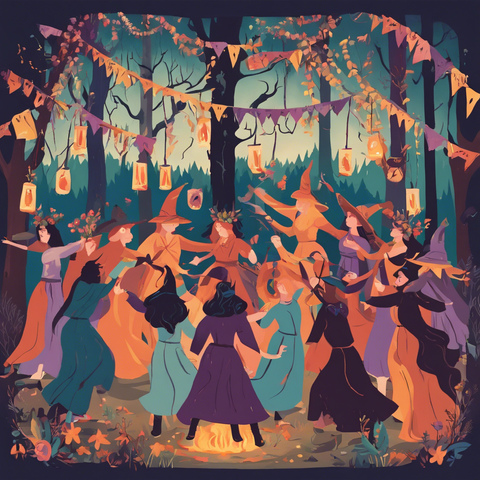Blooming into Balance: Celebrating Ostara 2025
The air is changing. A gentle warmth replaces the winter’s chill, and the world awakens with a vibrant burst of life. Ostara, the Spring Equinox, is upon us! This Pagan Sabbat marks the moment when day and night are of equal length, a perfect balance before the sun’s power begins to dominate. In 2025, we’ll be celebrating Ostara on Thursday, March 20th.
Ostara is a time of renewal, rebirth, and growth. It’s a celebration of the Goddess Ostara (or Eostre), associated with dawn, spring, and fertility, and a welcoming of the returning sun. Let’s delve into how you can celebrate this vibrant Sabbat, whether you’re a solitary practitioner or part of a coven.
💫 Correspondences of Ostara
💫 Deities:
Ostara/Eostre, Persephone, Flora, Green Man, any deities associated with spring, dawn, and fertility.
💫 Colors:
Pastel shades of green, yellow, pink, white, and light blue.
💫 Symbols:
Eggs, rabbits, hares, flowers (especially daffodils, tulips, and crocuses), seeds, budding trees, lambs, butterflies.
💫 Herbs and Flowers:
Daffodils, tulips, crocuses, violets, honeysuckle, sage, and anything new and green.
💫 Stones:
Rose quartz, aquamarine, moonstone, and any light-colored crystals.
💫 Incense/Oils:
Floral scents like jasmine, rose, and violet, as well as light, fresh scents like lemon and sandalwood.
💫 Foods:
Eggs (decorated and plain), leafy greens, spring vegetables, seeds, honey cakes, and fruit.
_______________________________
✨ Altar Setup
Your Ostara altar should reflect the vibrancy & colors of spring and can be in or outdoors.
Consider:
✨ A white or pastel-colored altar cloth.
✨ Fresh flowers in a vase.
✨ Decorated eggs or a nest of eggs.
✨ Images or figurines of rabbits or hares.
✨ Seeds or small potted plants.
✨ Candles in Ostara colors.
✨ Crystals that resonate with the season.
✨ A bowl of spring water.
✨ A representation of your chosen deities.
_______________________________
🌛Rituals for Ostara
🌛 Planting Ritual:
Plant seeds or seedlings to symbolize new beginnings and growth. As you plant, speak your intentions aloud.
🌛 Equinox Meditation:
Find a quiet space and meditate on the balance of light and dark, the renewal of nature, and your own personal growth.
🌛 Journaling:
Reflect on your goals and intentions for the coming season. Write about what you want to grow and cultivate in your life.
🌛 Offering Ritual:
Make offerings to Ostara or your chosen deities, such as flowers, seeds, or honey cakes.
🌛 Spring Cleansing Ritual:
Cleanse your home and sacred space, both physically and energetically, to make way for new energy. Use sage, palo santo, or spring-scented essential oils.
_______________________________
Solitary Practitioner Activities
🌟 Nature Walk:
Spend time in nature, observing the signs of spring. Gather flowers, leaves, or stones to add to your altar.
🌟 Crafting:
Create Ostara-themed crafts, such as egg decorations, flower crowns, or nature mandalas.
🌟 Baking:
Bake spring-themed treats, such as honey cakes or egg-rich pastries.
🌟 Dawn Meditation:
Wake up early and greet the sunrise, welcoming the return of the light.
_______________________________
Coven Activities
🌟 Plant a communal garden or tree, symbolizing the coven’s shared growth and intentions.
🌟 Egg Hunt:
Organize an egg hunt with hidden blessings or messages inside the eggs.
🌟 Circle Casting:
Perform a group ritual to honor Ostara, invoking the energies of spring and balance.
🌟 Potluck Feast:
Share a meal of spring-inspired dishes, celebrating the abundance of the season.
🌟 Storytelling and Singing:
Share stories and songs related to Ostara and the spring season.
🌟 Maypole Dancing (If appropriate):
Maypoles are often associated with Beltane, but as the spring energies rise, a smaller maypole dance could be incorporated to celebrate the returning fertility of the earth.
______________________________
Ostara whispers of fresh starts and the quiet strength of budding life. It’s a time to turn inward, to examine the seeds of your own dreams, and gently coax them into bloom. Whether you find solace in solitary reflection or joy in shared celebration, take this moment to truly connect with the earth’s awakening. Listen to the birdsong, feel the sun’s gentle warmth, and let the promise of spring fill your heart. Plant your intentions with care, nurture them with kindness, and watch as your own unique potential unfolds. May your Ostara be filled with personal growth, renewed hope, and the blossoming of your truest self. Happy Ostara!
____________________________
🌈 Ostara Ritual for Renewal
The Seed of Potential: An Ostara Ritual for Renewal
Choose a space where you feel connected to nature, whether it’s outdoors or a designated sacred space indoors.
Welcome, fellow seekers, to the vibrant dawn of Ostara. As the Earth awakens from its winter slumber, we too are called to embrace renewal and growth. This ritual is designed to honor the Spring Equinox, the moment of perfect balance, and to plant the seeds of our own potential.
__________________________
Preparation
🌈 Timing:
Perform this ritual on the Spring Equinox, ideally at dawn or during the day when the sun is high.
🌈 Location:
Choose a space where you feel connected to nature, whether it’s outdoors or a designated sacred space indoors
🌈 Altar:
Set up your Ostara altar with the correspondences mentioned in the previous blog. Include a small pot of soil, seeds (representing your intentions), and a bowl of fresh spring water.
🌈 Tools:
You will need candles (pastel colors), incense (floral or fresh scents), and a representation of the Goddess Ostara (or your chosen spring deity).
____________________________
⭐ The Ritual ⭐
🌈 Casting the Circle:
If you typically cast a circle, do so now, invoking the elements and guardians.
🌈 Invocation:
Light your candles and incense. Stand before your altar and say:
“Ostara, Goddess of Dawn and Spring, we welcome your light. The Earth awakens, and so do we. We gather here, at the point of perfect balance, to honor the return of life and the blooming of potential.”
🌈 Honoring the Equinox:
Take a moment to feel the balance of light and dark. Close your eyes and visualize the sun rising, bringing warmth and vitality to the Earth. Say:
“Day and night are equal, a moment of perfect harmony. We honor the balance within and without, the dance of light and shadow, and the promise of growth.”
🌈 Planting the Seeds of Intention:
Take the pot of soil and the seeds. As you hold the seeds, visualize your intentions for the coming season. What do you wish to cultivate in your life? Speak your intentions aloud, infusing the seeds with your energy.
“These seeds represent the potential within me. I plant them with intention, nurturing my dreams and aspirations. May they grow strong and vibrant, bringing forth the fruits of my labor.”
Plant the seeds in the soil.
🌈 Blessing the Seeds and Water:
Hold the bowl of spring water over the planted seeds. Say:
“Water of life, nourish these seeds of intention. May they be blessed with growth, vitality, and abundance.”
Sprinkle the water over the soil.
🌈 Meditation and Visualization:
Sit or stand comfortably. Close your eyes and visualize your intentions taking root and flourishing. See them growing into vibrant manifestations of your desires. Feel the warmth of the sun and the gentle breeze of spring.
🌈 Offering to Ostara:
Offer a small gift to Ostara, such as flowers, a decorated egg, or a poem. Say:
“Ostara, we thank you for the gifts of spring. We offer our gratitude and respect, and we celebrate the renewal of life.”
🌈 Grounding:
Take a few deep breaths, grounding yourself in the present moment. Feel the connection to the Earth and the energy of spring.
🌈 Releasing the Circle:
If you cast a circle, release it now, thanking the elements and guardians.
🌈 Closing:
Extinguish the candles and incense. Place the pot of seeds in a sunny location and water them regularly, nurturing your intentions as they grow.
🌈 Reflection:
After the ritual, take some time to journal about your experience. Reflect on your intentions and how you plan to nurture them throughout the spring and summer. This ritual is a powerful way to connect with the energies of Ostara and to embrace the potential for growth within yourself. May your spring be filled with joy, abundance, and renewal.
Blessed Be!#Abundance #Astrology #CastingACircle #Celebrations #Cleansing #ColorCorrespondence #Correspondence #Crystals #Eostara #EssentialOils #Flowers #Gemstone #Grounding #Herbs #KitchenWitchcraft #Magic #Magick #Maypole #Meditation #Ostara #Pagan #Rites #Ritual #Rituals #Sabbat #SpringEquinox #Wiccan #Witch #WitchPowers #WitchTools #Witchcraft


